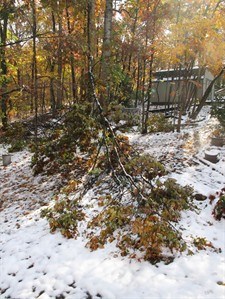
This image taken on Oct. 30, 2011shows damaged trees from a mid-October storm that packed wet, heavy snow that struck portions of Virginia's Shenandoah Valley while trees were still leafed out, damaging or topping a great many that couldn't carry the load. This tree couldn't be saved and had to be removed. (AP Photo/Dean Fosdick)
January 02, 2013 - 8:34 AM
Even the sturdiest-looking trees can be brought down by high winds, heavy snow and ice, but there are ways you can limit the damage.
Here are some storm-proofing suggestions that will pay off over time, starting with determining which trees in your landscape are the most vulnerable.
"I'm a great believer in storm-proofing or preparing for anything that will have the most impact on your lifestyle," said Mark Chisholm, a third-generation arborist from Howell, N.J., and spokesman for Stihl Inc., a manufacturer of outdoor power tools.
"Try to prep your house and yard if you have the time," he said.
"Clear rain gutters so water will flow. Remove loose lawn furniture from decks. Stabilize trees around the house by cabling or tying them down, especially those that you know have structural flaws."
Additional tips:
— Get to know an arborist or tree-care professional — now. "When a storm hits, you'll likely be prioritized as an existing customer," said Chisholm, who works with the power industry clearing debris left behind by severe weather, including Hurricane Sandy in October.
— Get a pre-storm assessment to identify trouble spots. Decaying and leaning trees should be pruned, staked or removed, especially those threatening dwellings or utility lines.
— Think safety during cleanup. "The stuff on the ground won't hurt you unless downed power lines are involved," Chisholm said. "It's what's overhead that's dangerous. Stress fractures or dead and broken limbs can come crashing down and do serious harm."
— Be especially careful when working with chainsaws. "If a tree is on the ground, try to cut it up without harming yourself in the process," said Kim Gabel with University of Florida Extension in Key West. "If a badly damaged tree is still standing, it's not recommended that a layman climb a ladder to take care of it. Get professional help."
— Patience can be a money-saver when dealing with ice or snow loads on trees. "Wait until it melts and the weight is removed to see what kind of damage was done," Chisholm said. "Trees are resilient and are capable of bouncing back."
— Plant native trees rather than exotics. Some varieties fare better than others in storms, especially trees with conical branching, those with strong branch connections and trees that are small when mature, according to the Insurance Institute for Business and Home Safety.
— There is strength in numbers. "Trees planted in groups survive better in high winds," Chisholm said. "They can't bend as readily to the point of failure. They also help dampen the (wind) force."
— Learn how to assess damage. "If you have a tree that has lost a couple of branches of significant size but the trunk is mostly intact, that's still a keeper," said Hank Stelzer, a state forestry specialist with University of Missouri Extension. "If you lose the top of a tree from ice or a windstorm and if half or a quarter of the trunk is gone, that's a no-brainer. It should go."
___
Online:
For more about First Aid for storm-damaged trees, see this University of Missouri Extension fact sheet: http://extension.missouri.edu/p/G6867
You can contact Dean Fosdick at deanfosdick(at)netscape.net
News from © The Associated Press, 2013